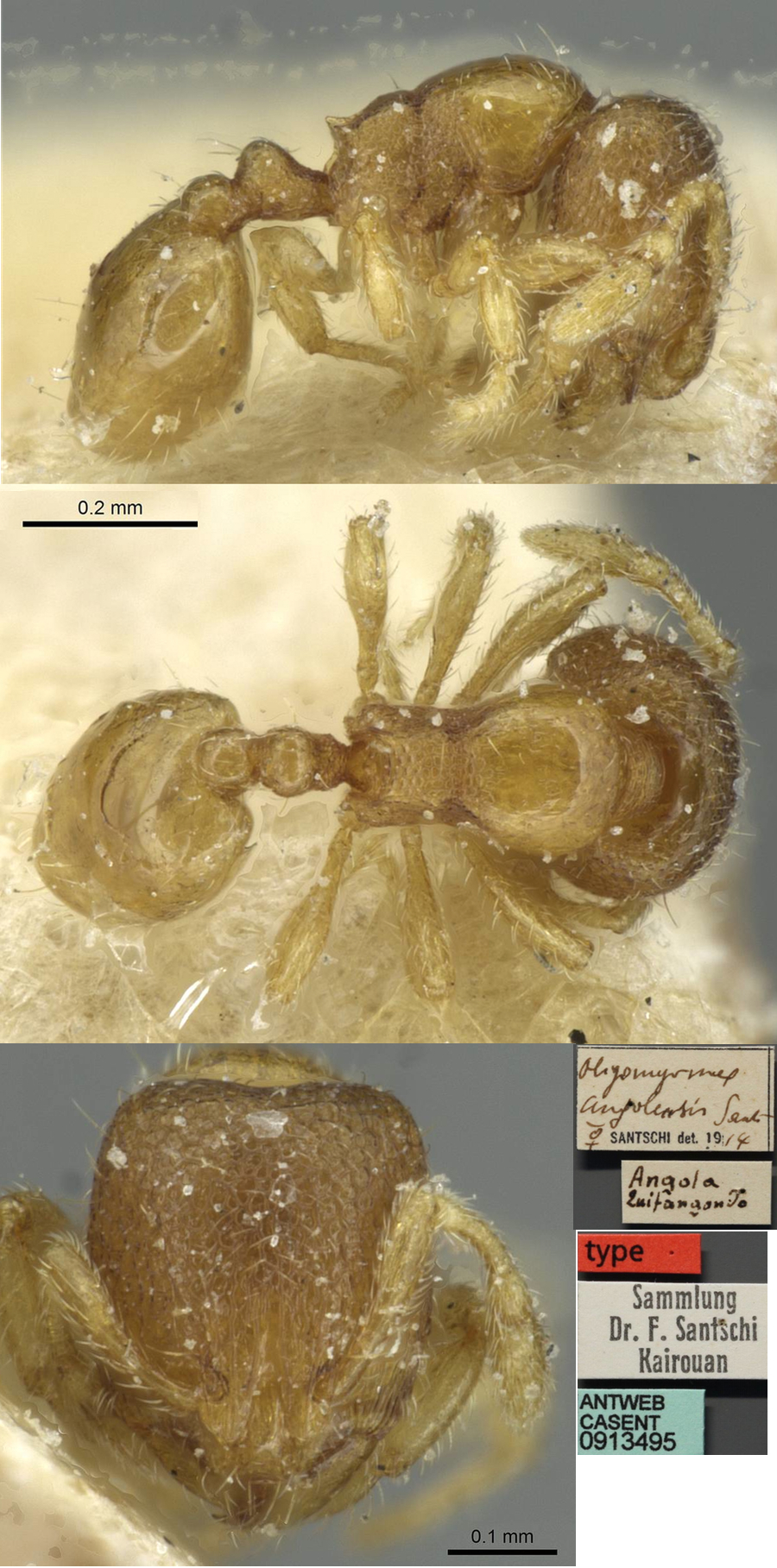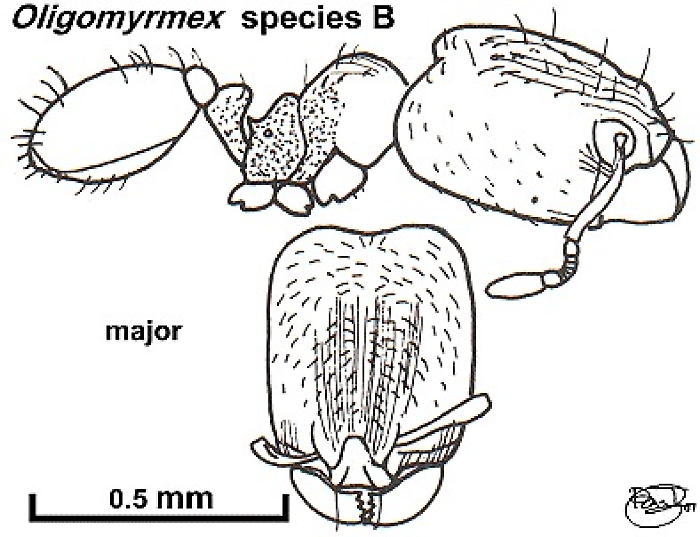Oligomyrmex (Oligomyrmex) angolensis Santschi
Major -  Minor - Minor -   Type location Angola
(Oligomyrmex angolensis n.
sp., Santschi, 1914d: 358, illustrated, major & minor) - see below Type location Angola
(Oligomyrmex angolensis n.
sp., Santschi, 1914d: 358, illustrated, major & minor) - see below
subspecies congolensis
(Oligomyrmex angolensis Sants.
r. congolensis n. stirps,
Forel, 1916: 417, major &
minor) from Zaïre, by H. Kohl - see http://www.antweb.org/specimenImages.do?code=casent0908895
major & minor described (see Bolton, 1995)  . .
|
 Santschi's
(1914d) description is at Santschi's
(1914d) description is at  . .
Weber
(1950a: 4) had the following translation (amended
by me) -
MAJOR (after SANTSCHI): TL 0.9-1 mm. Head rectangular, a fourth longer
than broad, with sides a little convex and occipital margin slightly
emarginate; eyes of one facet, a little in front of the middle of the
sides; clypeus bicarinate, emarginate in the middle of the anterior
border, convex; scape slightly surpassing the middle of the head,
antennal segments 3 to 7 slightly broader than long, the terminal
segment as long as the six preceding when taken together; mandibles
four-toothed. Pro-mesonotum globose, a little longer than broad, with
the pro-mesonotal suture little distinct; metanotal suture very
impressed; basal face (of propodeum) marginate, concave and enlarged
behind, slightly longer than broad, terminating in two teeth as long as
a fourth their interval, broad at their base; declivity strongly
marginate, concave. Petiole a little lower than long, the node rounded
at the summit, almost twice as broad as long. Post-petiolar summit
slightly broader than the petiole but only a fourth shorter than broad.
Gaster short, emarginate at each side of the pedicel. Very near to Oligomyrmex
alluaudi and jeanneli, but the first has a shorter head and
the second has the sculpture more smooth. Mandibles, middle of the
clypeus, occiput, mesonotum and propodeum, summit of the nodes, and
gaster smooth and shining; head and remainder of the thorax matt and
punctate; head also densely and very finely striate longitudinally with
the base of the striations more shining and less punctate in front of
the cheeks and clypeus than behind; striations at the sides of the head
more or less anastomosing. Pilosity of a few long hairs on the body and
a pubescence distributed chiefly on the appendages and the head.
Reddish yellow, head more reddish, gaster brownish yellow, legs and
antennae yellow.
WORKER (after SANTSCHI): TL 0.8 mm. Head a little longer than broad,
longer than in alluaudi and less enlarged behind; the scape
nearly attains the posterior fourth of the head; mandibles of four
teeth. Thorax broad in front and more marginate than in alluaudi;
basal face of the propodeum clearly broader than long, with the teeth
moderate, somewhat broader at the base than long. Petiole a little
longer than high and a little broader at the summit than in alluaudi;
postpetiole rounded, narrower. Head, propodeum, and sides of the
petiole matt, densely and finely reticulate-punctate, the remainder
smooth and shining. Reddish yellow.
TYPE LOCALITY; Quifangondo, Angola.
|
Oligomyrmex angolensis subsp. congolensis
Forel
Forel's (1916) description of congolensis is at  . .
MAJOR (after FOREL): TL 1.4-1.5 mm. A little larger than
the type, similar form of the head, but the latter has a very small
carina on each side at the occiput. Clypeus strongly emarginate at the
middle of the anterior border but without lateral carinae sketched and
described by Santschi in the type. The extremity of the scape scarcely
surpasses the middle of the head. Thorax scarcely as impressed.
Propodeal teeth shorter than in those of the type, small and
triangular. Head subopaque and densely striate anteriorly; rest of body
shining and little sculptured. Dull, dirty yellow, head yellowish
brown) antennae and legs yellow.
WORKER (after FOREL): TL 0.9 mm. Antennal scape attains the posterior
fourth of the head; metanotal suture a little deeper and propodeal
teeth stronger than in the soldier. Petiole thicker and more rounded
above than in the soldier, where its node appears higher and more
compressed than in the type. Head matt, a little more reticulate and
less striate than in the soldier. Uniformly yellow with a touch of
russet except for yellow legs.
TYPE LOCALITY: Congo (Kohl).
|
 The photomontage of the
type major worker is collated from http://www.antweb.org/specimen.do?name=casent0913494 The photomontage of the
type major worker is collated from http://www.antweb.org/specimen.do?name=casent0913494
|
 The photomontage of a
minor
worker (listed by Santschi, 1913e) is collated from http://www.antweb.org/specimen.do?name=casent0913495 The photomontage of a
minor
worker (listed by Santschi, 1913e) is collated from http://www.antweb.org/specimen.do?name=casent0913495
|

Nigeria specimens (Oligomyrmex
(Oligomyrmex) species B, Taylor, 1980a: 37)
Major TL 1.43 mm, HL 0.51, HW 0.44, SL 0.23, PW 0.23;
Minor (not drawn) TL 0.86.
Colour darkish yellow-brown.
Major head unsculptured except for fine rugae on
the dorsum; lateral pronotum smooth; lateral mesonotum and propodeum
finely punctate. Erect hairs relatively sparse; head with very sparse
pilosity. Eye minute. Antennae 9-segmented. Propodeal spines minute and
triangular forming the upper end of flanges on the lower half of the
lateral propodeum.
Minor sculpturation similar but head
reticulopunctate.
Collected at the Cocoa Research Instutute of Nigeria,
Idi Ayunre, from a dead log, by B. Bolton.
Also found in Ghana in cocoa leaf litter at the
Mampong Cemetery farm (Room, 1971).
May be O. angolensis subspecies congolensis
|
Oxford University Museum
specimens
Oligomyrmex (O.) angolensis
B Taylor det. |
Gabon
Y Braet
Gabon 226
|
27.vi-10.vii.2006
Pongara
00°34' N
09°19' E
|
Leaf litter, winkler
funnel
|
1
|
 |
|
 The photomontage
is of a minor worker from Gabon,
Pongara National Park; collector Yves Braet (Gabon 226). The photomontage
is of a minor worker from Gabon,
Pongara National Park; collector Yves Braet (Gabon 226).
|
 The photomontage
is of a second minor worker from Gabon,
Pongara National Park; collector Yves Braet (Gabon 226). The photomontage
is of a second minor worker from Gabon,
Pongara National Park; collector Yves Braet (Gabon 226).
|
|